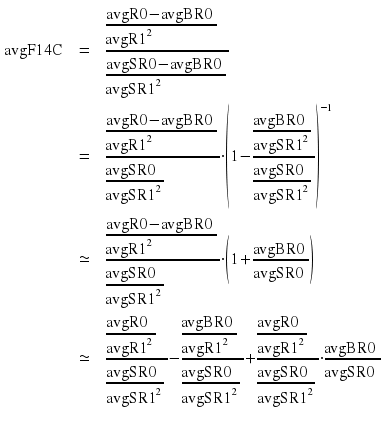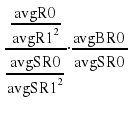
If R0 (14/12 ratio) of an unknown sample is less than the R0 of the designated backgrounds (ie F14C is negative) then the age is reported as a "greater than" age. The value of the "greater than" F14C is twice the uncertainty on the background. Stuiver and Pollach are ambiguous on whether the sample uncertainty or the background uncertainty should be used here. See the discussion below.
If F14C of an unknown sample is within two sample F14C standard deviations of the designated background then the sample F14C is increased by twice its F14C uncertainty. The following formulas illustrate this:

We estimate the uncertainty of our background measurement by determining the long term variance of our measured backgrounds and obtain a ratio of this variance with the long term average of our measured backgrounds. This ratio is multiplied with each day's measured background value and the result added in quadrature with the day's measured background uncertainty
The purpose of the next discussion is to look at the implications of an alternative way of making the background correction. This is to normalize the unknown to the standard before background correction. Starting with our original equation, one can make the following approximations:

There are 3 orders of magnitude difference between the activity of the BKG and the STD so unless the unknowns are fairly close to modern one can neglect the term

Therefore the approximate result is

where avgF14C1 denotes an avgF14C that has not been background corrected. In other words, as an approximation, background subtraction can be done after normalization. This result means that the error propagation for the F14C uncertainty is as follows:

This approximation has a significant impact on how the sigF14Cs are calculated. As shown above the error propagation of a difference is the sum of the squares of the terms. However, when the background is subtracted prior to normalization the final error propagation involves the quotient of terms and is proportional to the ratio itself. This means that if the activity of a sample is negative (due to being indistinguishable from background), the uncertainty is also negative. Stuiver and Pollach are not explicit about whether the uncertainty of the sample or the background is to be reported in that case, but certainly it appears that the background uncertainty is intended, since the sample uncertainty is negative, and therefore meaningless.